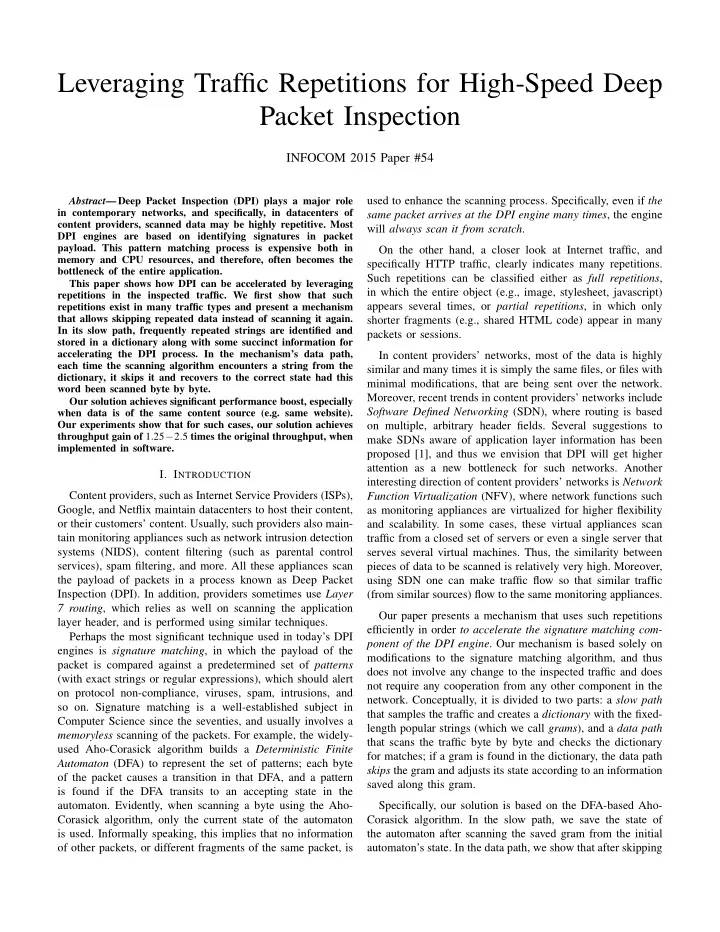

Leveraging Traffic Repetitions for High-Speed Deep Packet Inspection INFOCOM 2015 Paper #54 used to enhance the scanning process. Specifically, even if the Abstract — Deep Packet Inspection (DPI) plays a major role in contemporary networks, and specifically, in datacenters of same packet arrives at the DPI engine many times , the engine content providers, scanned data may be highly repetitive. Most will always scan it from scratch . DPI engines are based on identifying signatures in packet payload. This pattern matching process is expensive both in On the other hand, a closer look at Internet traffic, and memory and CPU resources, and therefore, often becomes the specifically HTTP traffic, clearly indicates many repetitions. bottleneck of the entire application. Such repetitions can be classified either as full repetitions , This paper shows how DPI can be accelerated by leveraging in which the entire object (e.g., image, stylesheet, javascript) repetitions in the inspected traffic. We first show that such appears several times, or partial repetitions , in which only repetitions exist in many traffic types and present a mechanism that allows skipping repeated data instead of scanning it again. shorter fragments (e.g., shared HTML code) appear in many In its slow path, frequently repeated strings are identified and packets or sessions. stored in a dictionary along with some succinct information for accelerating the DPI process. In the mechanism’s data path, In content providers’ networks, most of the data is highly each time the scanning algorithm encounters a string from the similar and many times it is simply the same files, or files with dictionary, it skips it and recovers to the correct state had this minimal modifications, that are being sent over the network. word been scanned byte by byte. Moreover, recent trends in content providers’ networks include Our solution achieves significant performance boost, especially Software Defined Networking (SDN), where routing is based when data is of the same content source (e.g. same website). Our experiments show that for such cases, our solution achieves on multiple, arbitrary header fields. Several suggestions to throughput gain of 1 . 25 − 2 . 5 times the original throughput, when make SDNs aware of application layer information has been implemented in software. proposed [1], and thus we envision that DPI will get higher attention as a new bottleneck for such networks. Another I. I NTRODUCTION interesting direction of content providers’ networks is Network Content providers, such as Internet Service Providers (ISPs), Function Virtualization (NFV), where network functions such Google, and Netflix maintain datacenters to host their content, as monitoring appliances are virtualized for higher flexibility or their customers’ content. Usually, such providers also main- and scalability. In some cases, these virtual appliances scan tain monitoring appliances such as network intrusion detection traffic from a closed set of servers or even a single server that systems (NIDS), content filtering (such as parental control serves several virtual machines. Thus, the similarity between services), spam filtering, and more. All these appliances scan pieces of data to be scanned is relatively very high. Moreover, the payload of packets in a process known as Deep Packet using SDN one can make traffic flow so that similar traffic Inspection (DPI). In addition, providers sometimes use Layer (from similar sources) flow to the same monitoring appliances. 7 routing , which relies as well on scanning the application Our paper presents a mechanism that uses such repetitions layer header, and is performed using similar techniques. efficiently in order to accelerate the signature matching com- Perhaps the most significant technique used in today’s DPI ponent of the DPI engine . Our mechanism is based solely on engines is signature matching , in which the payload of the modifications to the signature matching algorithm, and thus packet is compared against a predetermined set of patterns does not involve any change to the inspected traffic and does (with exact strings or regular expressions), which should alert not require any cooperation from any other component in the on protocol non-compliance, viruses, spam, intrusions, and network. Conceptually, it is divided to two parts: a slow path so on. Signature matching is a well-established subject in that samples the traffic and creates a dictionary with the fixed- Computer Science since the seventies, and usually involves a length popular strings (which we call grams ), and a data path memoryless scanning of the packets. For example, the widely- that scans the traffic byte by byte and checks the dictionary used Aho-Corasick algorithm builds a Deterministic Finite for matches; if a gram is found in the dictionary, the data path Automaton (DFA) to represent the set of patterns; each byte skips the gram and adjusts its state according to an information of the packet causes a transition in that DFA, and a pattern saved along this gram. is found if the DFA transits to an accepting state in the automaton. Evidently, when scanning a byte using the Aho- Specifically, our solution is based on the DFA-based Aho- Corasick algorithm, only the current state of the automaton Corasick algorithm. In the slow path, we save the state of is used. Informally speaking, this implies that no information the automaton after scanning the saved gram from the initial of other packets, or different fragments of the same packet, is automaton’s state. In the data path, we show that after skipping
Recommend
More recommend